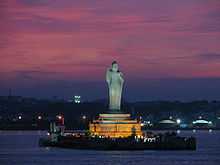Buddha Statue of Hyderabad
| Buddha Statue of Hyderabad | |
|---|---|
|
Standing Buddha in abhya mudra | |
| Location | Hussain Sagar, Hyderabad, Telangana, India |
| Coordinates | 17°24′56″N 78°28′30″E / 17.41556°N 78.47500°ECoordinates: 17°24′56″N 78°28′30″E / 17.41556°N 78.47500°E |
| Height | 58 feet (18 meters) |
| Dedicated | December 1, 1992 |
| Sculptor | S.M.Ganapathi Sthapati |
| Governing body | Buddha Purnima Project Authority, HMDA |
| Material | White Granite Stone |
.svg.png) Location of Buddha Statue in Hussain Sagar | |
The Buddha Statue of Hyderabad is a monolith located in India. It is the world's tallest monolith of Gautama Buddha.
History
Hyderabad is the capital of the state of Telangana. Between 1983 and 1989, N. T. Rama Rao served as the Chief Minister of Andhra Pradesh. During his tenure, he spent large sums to erect several statues of people from the region's political and religious history. During his visit to New York, he saw the Statue of Liberty and was inspired by the efforts to restore it. He said "I wanted something like that ... That would have been my contribution to society."[1]
Rama Rao chose to depict Gautama Buddha because "he was a humanitarian who told the whole truth to the people. It is our pride."[1] After a long search, he found a solid white granite rock near Nalgonda on a mountainside 40 miles outside Hyderabad. In October 1985 NTR inaugurated work on structure. For over a year, hundreds of labourers helped the temple architect and builder S.M.Ganapathi Sthapati create the statue. After five years and the expenditure of US$3 million,[1] the statue stood at 58 feet (18 m) and weighed 350 tons, making it the world's tallest monolithic statue of the Buddha.[2] A concrete platform measuring 15 feet (4.6 m), now referred to as the "Rock of Gibraltar,"[3] was constructed in the middle of Hussain Sagar to aid in erecting the statue. The roads of the city were also widened for this purpose.[1]
This statue is located at Lumbini Park in the Husain Sagar Island can be reached by boat in 15 minutes.[4]
The accident
Then government of Andhra Pradesh led by N. T. Rama Rao was ousted in 1989. By the next year, the statue was ready for erection. ABC Limited, a local company, was given the responsibility of transferring the statue onto the concrete platform. Using a trailer vehicle, the statue was brought to the shore of Hussain Sagar. On March 10, 1990, company workers shifted the statue on top of a barge. After traveling only 100 yards (91 m), the statue tipped and fell into the lake.[1][5] The accident killed 10 people.[6]
After a two-year salvage operation, the statue was pulled out of the lake.[2] On December 1, 1992, the statue was installed on the platform successfully. In 2006, the Dalai Lama consecrated the statue after performing a ritual.[7]
See also
Gallery
-
Standing Buddha in abhya mudra
-
Closeup view
-
Sunset on Buddha Statue, Hussain Sagar
-

Evening View
-

Night View on a moon day
-
A sculpture on the basement of Buddha statue.
-

Buddha statue at Hussain sagar
References
- ↑ 1.0 1.1 1.2 1.3 1.4 Coll, Steve (April 9, 1990). "Buddha of the Lake Bottom". The Washington Post. Retrieved September 9, 2012. – via HighBeam Research (subscription required)
- ↑ 2.0 2.1 "Up from the bottom". The Boston Globe (Boston, MA). April 19, 1992. Retrieved September 9, 2012. – via HighBeam Research (subscription required)
- ↑ Raje, Abhishek (January 23, 2012). "Ram Charan Teja shoots at iconic Buddha statue". The Times of India (Hyderabad). Times News Network. Retrieved September 9, 2012.
- ↑ Goldberg, Kory., Décary, Michelle.(2012), “The South: Hydrabad” , Along the Path: The Meditator's Companion to the Buddha's Land, Pariyatti Publisher, p.372. ISBN 1938754034 , 9781938754036
- ↑ "10 drown as the statue of Buddha takes a dip". New Straits Times (New Delhi). March 11, 1990. Retrieved September 9, 2012.
- ↑ "Buddha Statue Sinks Barge, Drowning 10". St. Louis Post-Dispatch (New Delhi). Associated Press. March 11, 1990. pp. 13A.
- ↑ "Buddha statue consecrated". The Hindu (Hyderabad). January 3, 2006. Retrieved September 9, 2012.
- Shifting Stones, Shaping the Past: Sculpture from the Buddhist Stupas of Andhra Pradesh - Book
| Wikimedia Commons has media related to Buddha Statue of Hyderabad. |



